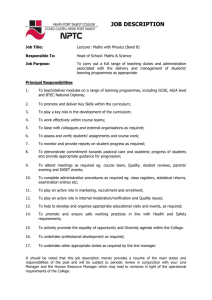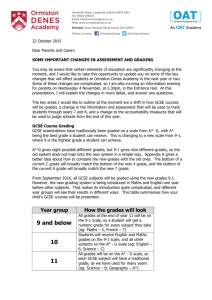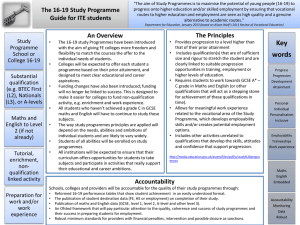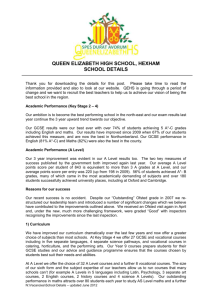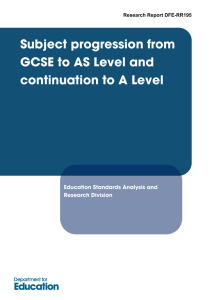Ann Hodgson and Ken Spours - Hertfordshire Grid for Learning
advertisement
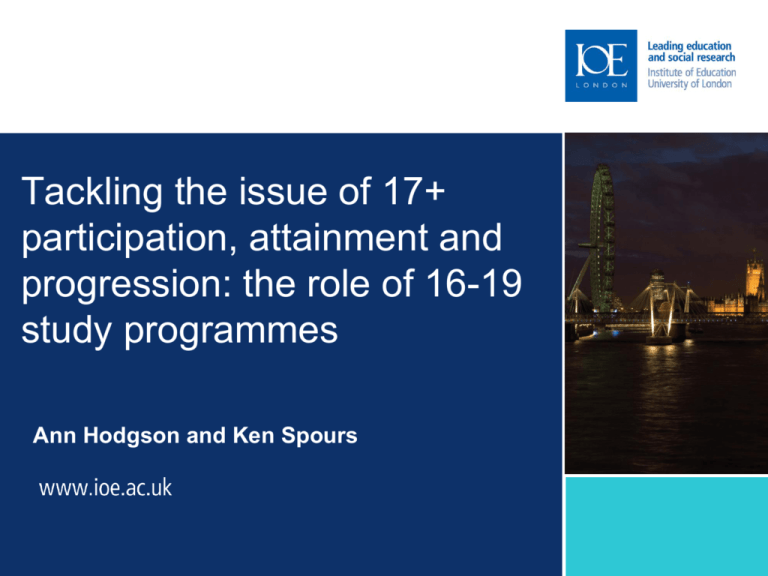
Tackling the issue of 17+ participation, attainment and progression: the role of 16-19 study programmes Ann Hodgson and Ken Spours The international context for upper secondary education • Participation in upper secondary education systems (USE) is increasing in both developed and developing countries • This is the result of universal primary education, globalisation and the international competition for high skilled employment • International benchmarks such as PISA and TIMSS are encouraging countries to reconsider their USE systems • Countries are reforming in different ways according to history, economic position and culture, but neo-liberal ideas are very powerful • Wider global trends have been towards integration and unification rather than segregation and tracking in USE 2 Tensions within USE as it becomes universal • Encompasses both compulsory and post-compulsory education - end point for some young people but preparatory stage for others. • Major source of social and education division and a focus of social contestation where young people’s future life chances are increasingly determined. • Need to balance: commonality of experience for social cohesion diversity to address the needs of a much broader population universal need for 21st century competences with increasing specialisation. The 17+ issue • RPA and the importance of sustained and high quality participation post-16 • Avoiding a ‘wasted’ year • 17+ participation is the major indicator of potential success at Level 3 and progression from Level 2 to Level 3 • But 17+ is also major point of potential disruption in progression • It is arguably becoming the new point of selection • A complex mix of national, local and institutional factors combine at this stage 17+ in London: key participation & retention statistics (schools) • 17+ retention on schools’ A Level programmes (82%) greater than on schools’ Level 3 vocational programmes (59%). Just under a quarter of Year 12 Level 3 starters had left the sixth form before 18. • Drop out from Level 3 programmes in schools and colleges was primarily at the end of Year 12, particularly for vocational courses. • GCSE attainment affects 17+ participation (remaining until Year 13) • • • • 5 A*-C grades (GCSE only) 5 A*-C grades (GCSE only) including English and Maths 8+ A*-C grades or equivalent including English and Maths 8+ A*-C (GCSE only) grades including English and Maths 72% 87% 87% 91% 17+ in London: key Level 3 attainment statistics (schools) • Broader achievement at Key Stage 4 produces better outcomes post16. - 65% of London Level 3 learners have at least 5 GCSE A*-C grades including maths and English and they score on average 753 points (just above the national average). - Those with 8+ GCSE A*-C grades including maths and English score on average 795 points – 40 points above the national average. - However, about 30 per cent of Level 3 learners in London schools do not have A*-C grades in English and Maths. Overall, they score on average 540 points compared to the national average of 740 points (This brings the overall London figure down) Level 2 to Level 3 progression in schools Possible causes • Drop-out during the Level 2 course (about 30 per cent) • Non-achievement of Merit or Distinction grades to be able progress to Level 3 (50%) • The pull of the casualised labour market and caring responsibilities at home. The 17+ issue – a model of risk factors The potential role of 16-19 programmes of study • Inclusion of Level 2 English and Maths for progression • A possible mix of general and vocational study • A possible mix of Level 2 and Level 3 qualifications for learners with lower GCSE profiles • Inclusion of work experience for motivation, vocational learning and progression • Inclusion of an Extended Project Qualification for both motivation and skill building • Tutorial support, careful monitoring of progress and CEIAG Areas for consideration • Building in progression skills in Key Stage 4 • More liaison between Key Stage 4 and Key Stage 5 tutors/teachers • Admissions policies for sustained 17+ participation, particularly for Level 3 learners • Building expertise for high quality, effective and differentiated A Level teaching through ‘communities of practice’ • The role of CEIAG both pre- and post-16 • The possibilities of a ‘three-year sixth’ • A focus on sustained 17+ participation and progression - avoiding low grades, drop-down and drop-out

